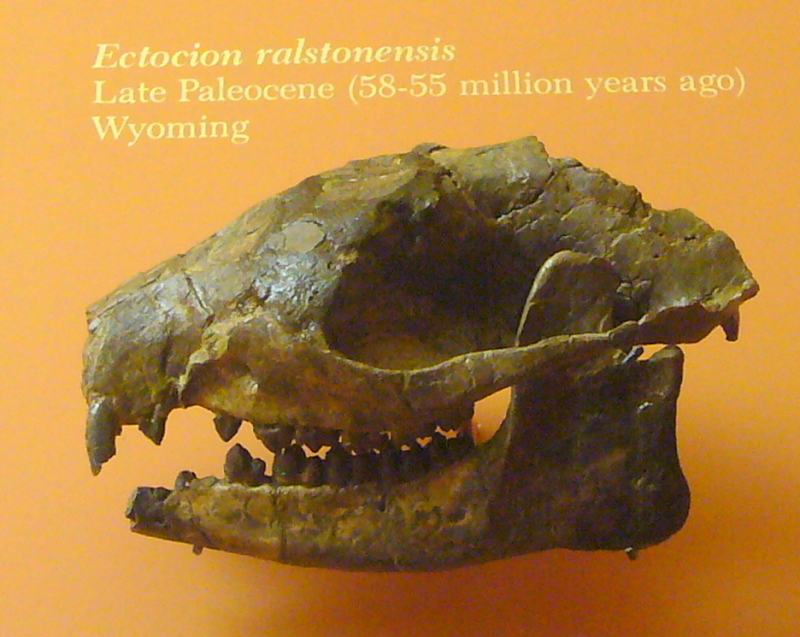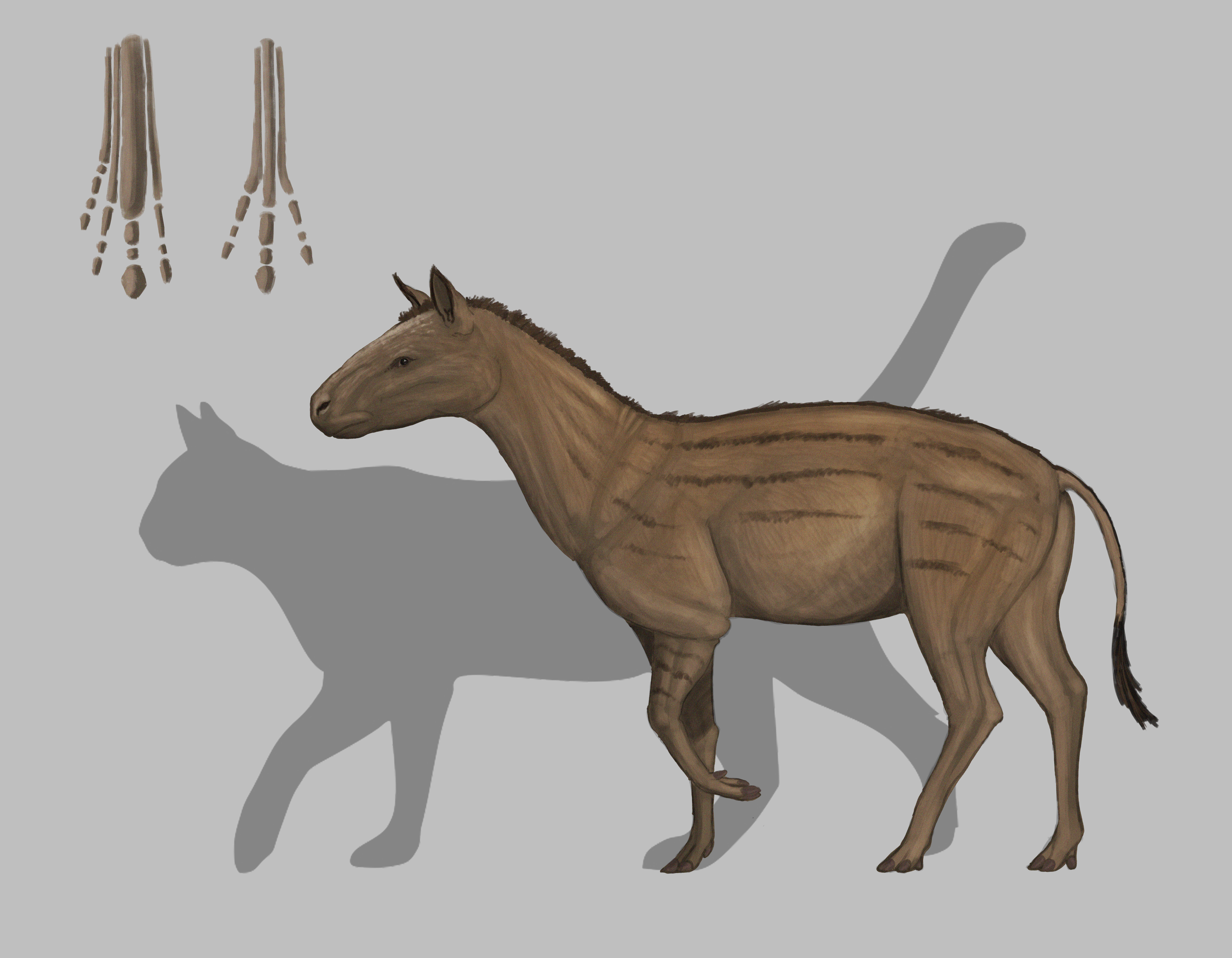|
Phenacodus
''Phenacodus'' (Greek: "deception" (phenax), "tooth' (odus)) is an extinct genus of mammals from the late Paleocene through middle Eocene, about 55 million years ago. It is one of the earliest and most primitive of the ungulates, typifying the family Phenacodontidae and the order Perissodactyla. Description ''Phenacodus intermedius'' reached , while ''P. trilobatus'' is estimated at . The typical ''Phenacodus primaevus'' was a relatively small ungulate about long and weighed up to , of slight build, with straight limbs each terminating in five complete toes, and walking in the digitigrade fashion of the modern horse. The middle toe was the largest, and the weight of the body was mainly supported on this and the two adjoining digits, which appear to have been encased in hooves, foreshadowing the tridactyl type common in perissodactyls and certain extinct groups of ungulates. The skull was small, with proportionately minute brain; and the arched back, strong lumbar vertebrae, lon ... [...More Info...] [...Related Items...] OR: [Wikipedia] [Google] [Baidu] |
Phenacodontidae
Phenacodontidae is an extinct family of large herbivorous mammals traditionally placed in the “wastebasket taxon” Condylarthra, which may instead represent early-stage perissodactyls. They lived from the late early Paleocene to early middle Eocene (about 60–50 million years ago) and their fossil remains have been found in North America and Europe. The only unequivocal Asian phenacodontid is '' Lophocion asiaticus''. Description These animals had a variety of body sizes, and could be as small as domestic cats ('' Tetraclaenodon'' and '' Ectocion'') and as large as sheep ('' Phenacodus''). The skull of phenacodontids is long and narrow, and equipped with a small braincase. The skeleton of phenacodontids show several primitive characteristics (the long and heavy tail for example) but also a number of advanced, Perissodactyla-like adaptations: Their long legs, for example, had five fingers, but the first finger showed a clear reduction, and in some forms (like ''Phenacod ... [...More Info...] [...Related Items...] OR: [Wikipedia] [Google] [Baidu] |
Phenacodus Primaevus Skeleton (cropped)
''Phenacodus'' (Greek: "deception" (phenax), "tooth' (odus)) is an extinct genus of mammals from the late Paleocene through middle Eocene, about 55 million years ago. It is one of the earliest and most primitive of the ungulates, typifying the family Phenacodontidae and the order Perissodactyla. Description ''Phenacodus intermedius'' reached , while ''P. trilobatus'' is estimated at . The typical ''Phenacodus primaevus'' was a relatively small ungulate about long and weighed up to , of slight build, with straight limbs each terminating in five complete toes, and walking in the digitigrade fashion of the modern horse. The middle toe was the largest, and the weight of the body was mainly supported on this and the two adjoining digits, which appear to have been encased in hooves, foreshadowing the tridactyl type common in perissodactyls and certain extinct groups of ungulates. The skull was small, with proportionately minute brain; and the arched back, strong lumbar vertebrae, long ... [...More Info...] [...Related Items...] OR: [Wikipedia] [Google] [Baidu] |
Meniscotherium
''Meniscotherium'' is an extinct genus of dog-sized mammal which lived 54–38 million years ago. It was a herbivore and had hooves. Fossils have been found in Utah, New Mexico. and Colorado. Many individuals have been found together, indicating that it lived in groups. Body mass in ''M. chamense'' is estimated to be 5–17 kg, making it about the size of a small dog. A 2014 cladistic analysis places it within stem perissodactyl Perissodactyla (, ), or odd-toed ungulates, is an order of Ungulate, ungulates. The order includes about 17 living species divided into three Family (biology), families: Equidae (wild horse, horses, Asinus, asses, and zebras), Rhinocerotidae ( ...s. References {{Taxonbar, from=Q4289003 Phenacodontidae Eocene mammals of North America Fossil taxa described in 1874 Prehistoric placental genera Taxa named by Edward Drinker Cope ... [...More Info...] [...Related Items...] OR: [Wikipedia] [Google] [Baidu] |
Condylarthra
Condylarthra is an informal group – previously considered an order – of extinct placental mammals, known primarily from the Paleocene and Eocene epochs. They are considered early, primitive ungulates and is now largely considered to be a wastebasket taxon, having served as a dumping ground for classifying ungulates which had not been clearly established as part of either Perissodactyla or Artiodactyla, being composed thus of several unrelated lineages. Taxonomic history Condylarthra always was a problematic group. When first described by , Phenacodontidae was the type and only family therein. , however, raised Condylarthra to an order and included a wide range of diverse placentals with generalized dentitions and postcranial skeletons. More recent researchers (i.e. post-WW2) have been more restrictive; either including only a limited number of taxa, or proposing that the term should be abandoned altogether. Due to their primitive characteristics condylarths have been consi ... [...More Info...] [...Related Items...] OR: [Wikipedia] [Google] [Baidu] |
Lumbar Vertebrae
The lumbar vertebrae are located between the thoracic vertebrae and pelvis. They form the lower part of the back in humans, and the tail end of the back in quadrupeds. In humans, there are five lumbar vertebrae. The term is used to describe the anatomy of humans and quadrupeds, such as horses, pigs, or cattle. These bones are found in particular cuts of meat, including tenderloin or sirloin steak. Human anatomy In human anatomy, the five vertebrae are between the rib cage and the pelvis. They are the largest segments of the vertebral column and are characterized by the absence of the foramen transversarium within the transverse process (since it is only found in the cervical region) and by the absence of facets on the sides of the body (as found only in the thoracic region). They are designated L1 to L5, starting at the top. The lumbar vertebrae help support the weight of the body, and permit movement. General characteristics The adjacent figure depicts the general cha ... [...More Info...] [...Related Items...] OR: [Wikipedia] [Google] [Baidu] |
Artiodactyl
Artiodactyls are placental mammals belonging to the order Artiodactyla ( , ). Typically, they are ungulates which bear weight equally on two (an even number) of their five toes (the third and fourth, often in the form of a hoof). The other three toes are either present, absent, vestigial, or pointing posteriorly. By contrast, most perissodactyls bear weight on an odd number of the five toes. Another difference between the two orders is that many artiodactyls (except for Suina) digest plant cellulose in one or more stomach chambers rather than in their intestine (as perissodactyls do). Molecular biology, along with new fossil discoveries, has found that cetaceans (whales, dolphins, and porpoises) fall within this taxonomic branch, being most closely related to hippopotamuses. Some modern taxonomists thus apply the name Cetartiodactyla () to this group, while others opt to include cetaceans within the existing name of Artiodactyla. Some researchers use "even-toed ungulates" t ... [...More Info...] [...Related Items...] OR: [Wikipedia] [Google] [Baidu] |
Equidae
Equidae (commonly known as the horse family) is the Taxonomy (biology), taxonomic Family (biology), family of Wild horse, horses and related animals, including Asinus, asses, zebra, zebras, and many extinct species known only from fossils. The family evolved more than 50 million years ago, in the Eocene epoch, from a small, multi-toed ungulate into larger, single-toed animals. All Extant taxon, extant species are in the genus ''Equus (genus), Equus'', which originated in North America. Equidae belongs to the order Perissodactyla, which includes the extant tapirs and rhinoceros, and several extinct families. It is more specifically grouped within the superfamily (taxonomy), superfamily Equoidea, the only other family being the extinct Palaeotheriidae. The term equid refers to any member of this family, including any equinae, equine. Evolution The oldest known fossils assigned to Equidae were found in North America, and date from the early Eocene epoch, 54 million years ago. Th ... [...More Info...] [...Related Items...] OR: [Wikipedia] [Google] [Baidu] |
Hyracotherium
''Hyracotherium'' ( ; "hyrax-like beast") is an extinction, extinct genus of small (about 60 cm in length) perissodactyl ungulates that was found in the London Clay formation. This small, fox-sized animal is (for some scientists) considered to be the earliest known member of Equidae before the type species, ''H. leporinum'', was reclassified as a palaeothere, a perissodactyl family (biology), family related to both horses and brontotheres. The remaining species are now thought to belong to different genera, such as ''Eohippus'', which had previously been synonymised with ''Hyracotherium''. Description ''Hyracotherium'' averaged 78 cm (2.5 feet) in length and weighed about 9 kg (20 pounds). It had a short face with eye sockets in the middle and a short diastema (the space between the front teeth and the cheek teeth). The skull was long, having 44 low-crowned teeth. Although it had low-crowned teeth, the beginnings of the characteristic horse-like ridges on the molars ... [...More Info...] [...Related Items...] OR: [Wikipedia] [Google] [Baidu] |
Tetraclaenodon
''Tetraclaenodon'' was a genus of small and early ungulate mammals that was part of the Phenacodontidae family. It is the oldest and most primitive phenacodontid. Its fossils known from the Nacimiento Formation, New Mexico New Mexico is a state in the Southwestern United States, Southwestern region of the United States. It is one of the Mountain States of the southern Rocky Mountains, sharing the Four Corners region with Utah, Colorado, and Arizona. It also .... In 2012, ''Tetraclaenodon'' was defined as the basalmost member of the clade containing "Phenacodontidae" and Altungulata. References Phenacodontidae Prehistoric mammal genera Fossil taxa described in 1892 Paleocene mammals of North America {{paleo-oddtoedungulate-stub ... [...More Info...] [...Related Items...] OR: [Wikipedia] [Google] [Baidu] |







